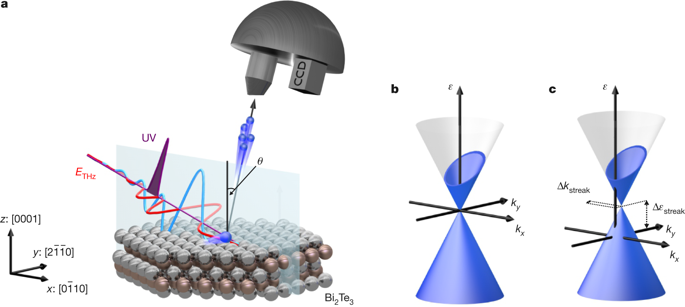Our official English website, www.x-mol.net, welcomes your
feedback! (Note: you will need to create a separate account there.)
Subcycle observation of lightwave-driven Dirac currents in a topological surface band
Nature ( IF 50.5 ) Pub Date : 2018-09-26 , DOI: 10.1038/s41586-018-0544-x J. Reimann , S. Schlauderer , C. P. Schmid , F. Langer , S. Baierl , K. A. Kokh , O. E. Tereshchenko , A. Kimura , C. Lange , J. Güdde , U. Höfer , R. Huber
Nature ( IF 50.5 ) Pub Date : 2018-09-26 , DOI: 10.1038/s41586-018-0544-x J. Reimann , S. Schlauderer , C. P. Schmid , F. Langer , S. Baierl , K. A. Kokh , O. E. Tereshchenko , A. Kimura , C. Lange , J. Güdde , U. Höfer , R. Huber

|
Harnessing the carrier wave of light as an alternating-current bias may enable electronics at optical clock rates1. Lightwave-driven currents have been assumed to be essential for high-harmonic generation in solids2–6, charge transport in nanostructures7,8, attosecond-streaking experiments9–16 and atomic-resolution ultrafast microscopy17,18. However, in conventional semiconductors and dielectrics, the finite effective mass and ultrafast scattering of electrons limit their ballistic excursion and velocity. The Dirac-like, quasi-relativistic band structure of topological insulators19–29 may allow these constraints to be lifted and may thus open a new era of lightwave electronics. To understand the associated, complex motion of electrons, comprehensive experimental access to carrier-wave-driven currents is crucial. Here we report angle-resolved photoemission spectroscopy with subcycle time resolution that enables us to observe directly how the carrier wave of a terahertz light pulse accelerates Dirac fermions in the band structure of the topological surface state of Bi2Te3. While terahertz streaking of photoemitted electrons traces the electromagnetic field at the surface, the acceleration of Dirac states leads to a strong redistribution of electrons in momentum space. The inertia-free surface currents are protected by spin–momentum locking and reach peak densities as large as two amps per centimetre, with ballistic mean free paths of several hundreds of nanometres, opening up a realistic parameter space for all-coherent lightwave-driven electronic devices. Furthermore, our subcycle-resolution analysis of the band structure may greatly improve our understanding of electron dynamics and strong-field interaction in solids.Time- and angle-resolved photoemission spectroscopy reveals how Dirac fermions in the band structure of the topological surface state of Bi2Te3 are accelerated by the carrier wave of a terahertz-frequency light pulse.
中文翻译:

拓扑表面带中光波驱动狄拉克电流的亚周期观测
利用光的载波作为交流偏置可以使电子设备处于光学时钟速率 1。光波驱动的电流被认为对于固体中的高次谐波产生 2-6、纳米结构中的电荷传输 7、8、阿秒条纹实验 9-16 和原子分辨率超快显微镜 17、18 是必不可少的。然而,在传统的半导体和电介质中,电子的有限有效质量和超快散射限制了它们的弹道偏移和速度。拓扑绝缘体 19-29 的类似狄拉克的准相对论能带结构可以解除这些限制,从而开启光波电子学的新时代。要了解电子的相关复杂运动,对载波驱动电流的综合实验访问至关重要。在这里,我们报告了具有亚周期时间分辨率的角分辨光电子能谱,使我们能够直接观察太赫兹光脉冲的载波如何在 Bi2Te3 的拓扑表面态的能带结构中加速狄拉克费米子。虽然光发射电子的太赫兹条纹追踪表面的电磁场,但狄拉克态的加速导致电子在动量空间中的强烈重新分布。无惯性表面电流受到自旋动量锁定的保护,并达到高达每厘米 2 安培的峰值密度,具有数百纳米的弹道平均自由程,为全相干光波驱动电子开辟了一个现实的参数空间设备。此外,
更新日期:2018-09-26
中文翻译:

拓扑表面带中光波驱动狄拉克电流的亚周期观测
利用光的载波作为交流偏置可以使电子设备处于光学时钟速率 1。光波驱动的电流被认为对于固体中的高次谐波产生 2-6、纳米结构中的电荷传输 7、8、阿秒条纹实验 9-16 和原子分辨率超快显微镜 17、18 是必不可少的。然而,在传统的半导体和电介质中,电子的有限有效质量和超快散射限制了它们的弹道偏移和速度。拓扑绝缘体 19-29 的类似狄拉克的准相对论能带结构可以解除这些限制,从而开启光波电子学的新时代。要了解电子的相关复杂运动,对载波驱动电流的综合实验访问至关重要。在这里,我们报告了具有亚周期时间分辨率的角分辨光电子能谱,使我们能够直接观察太赫兹光脉冲的载波如何在 Bi2Te3 的拓扑表面态的能带结构中加速狄拉克费米子。虽然光发射电子的太赫兹条纹追踪表面的电磁场,但狄拉克态的加速导致电子在动量空间中的强烈重新分布。无惯性表面电流受到自旋动量锁定的保护,并达到高达每厘米 2 安培的峰值密度,具有数百纳米的弹道平均自由程,为全相干光波驱动电子开辟了一个现实的参数空间设备。此外,











































 京公网安备 11010802027423号
京公网安备 11010802027423号